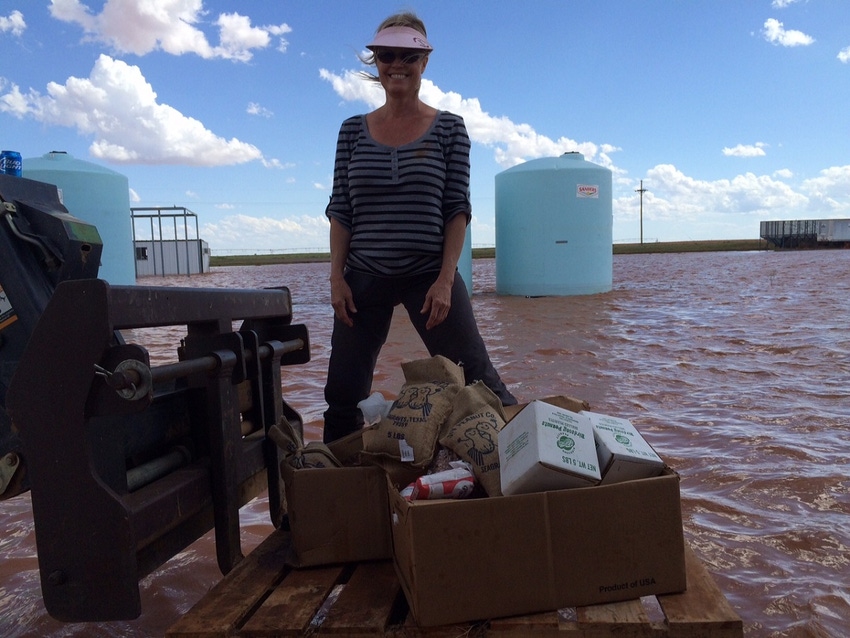
Sometimes a silver lining has a cloud.
Although greeted with mostly smiles and appreciation the recent storm systems that rolled across the Southwest also left destruction in its wake, including several fatalities from tornadoes, close calls from flash floods and damage to fields, equipment, ag facilities and even research plots.
J&V Peanut Company in Seagraves, Texas, for instance, is scraping out mud, cleaning facilities and trying to salvage equipment following a flood from the early May rainfall, more than 7 inches within a 12-hour period. “They got the first 4 inches in the first hour,” says Koby Reed of his parents, Joe and Vondee Reed’s, business. Sanders Chemical, on the same property, also suffered water damage from the flood.
As much as 1 foot of water rushed into the facility’s office, which was reworked from an old cotton gin office. “Some computers were knocked to the floor and were subject to water and sand damage,” Reed says. “Anything on the floor was ruined.”
The walls of the building were cinder block so they did not have to replace sheetrock.
Sanders Chemical had spray rigs parked on the premises and water rose above the tires. Reed says they may have to replace wheel bearings and some pumps. Not much seed was stored at the facility. “They may have lost a few bags of cotton or milo seed.
For the latest on southwest agriculture, please check out Southwest Farm Press Daily and receive the latest news right to your inbox.
“I had my four-wheel drive pickup parked in a shed and the water got inside and wet the floor mats. Dad also had some farm equipment stored and had some damage. “They may have to replace some pumps and electrical systems.”
The company had no flood insurance.
“It mostly just a wet mess,” Reed says, “and we can fix it. We’ve been scraping out mud and cleaning up to get back to normal after the water receded.”
It’s not all bad, he adds. “I’ve seen a lot of fields with washouts, but it was a good rain even if it tore stuff up. Some fields have been under water but folks are excited because it’s wet again.”
Reed, who farmed until this year and now works for a cotton merchant, says he’s more concerned about commodity prices. “I leased my land out this year after last season,” he says. “For the last five years it’s just been trying to get from one season to the next, just hang on and try to break even. If things don’t get better, we may lose some farmers.
Mixed Blessings
Across the state, the storms were a mixed blessing with most producers happy to have the moisture.
Over the last week, all of the state received rain, with 6 to 10 inches or more coming to parts of East, North and South Texas. Three to 4 inches was common to these areas, according to the National Weather Service.
In his weekly crop and weather roundup, Texas AgriLife media specialist Robert Burns says recent rainfall has hindered fieldwork across much of the state, delayed planting and processing hay. But the drought continues to decline.
“As a result of all the rain, only about 30 percent of the state was under moderate to exceptional drought, compared to 83 percent a year ago, according to the U.S. Drought Monitor,” Burns reports.
Other observations: In East Texas, the continued rain was great for forages, and cattle were gaining weight, but wet conditions continued to hinder fieldwork and hay harvesting. Heavy rains were washing out county roads and leaving standing water in cropland. “The rains were also pushing feral hogs out of low-lying, flooded areas and into pastures and cropland.”
“We have been receiving a lot of rain, so pastures have been too saturated for working,” said Shaniqua Davis, AgriLife Extension agent for Upshur County. Pastures have been too wet to work and some are developing fungi problems.
“Grass is tall, and some are cutting hay, while others want to, but fields are too wet to do so,” said Chad Gulley, AgriLife Extension agent for Smith County. “Cattle are in good condition and spring cattle work continues.”
“Pasture grasses are growing quickly because we’ve had so much moisture and warm weather,” said Armon Hewitt, AgriLife Extension agent for Trinity County. “But pastures are too wet to drive through for trucks and tractors alike. Erosion is becoming a problem in many places. Fertilizer is impossible to put out in most pastures as the spreader trucks with floatation tires are getting stuck.”
“This past week has brought a ton of rain to the county,” said Cody Maxwell, AgriLife Extension agent for Fannin County. “Wheat is headed out, looking good and starting to turn a little, but has been standing in water for most of last week.”
“(Last) week was very dry and windy at times as temperatures were in the upper 80s during the day and in the mid-70s at night,” Danielle Sekula reports from the Lower Rio Grande Valley in her weekly Pest Cast newsletter.
“Producers who planted by mid-February and in March accumulated a lot of heat units this past week as crops continued to mature. (This) week we are forecasted for rain throughout the week with the potential for some heavy rains. These rains will influence those fields that might need to have a spray application over the weekend prior to the rains.
In Chillicothe, a Texas AgriLife wheat field day schedule for May 13 was canceled because heavy winds knocked out test plots.
About the Author(s)
You May Also Like






